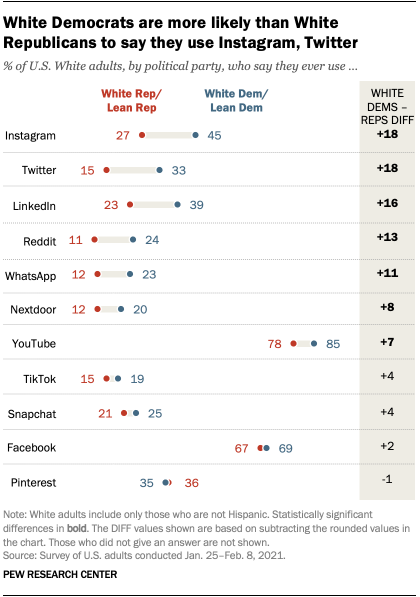Democrats are more likely than Republicans to say they use social media overall (77% and 68%, respectively), according to a new Pew Research Center survey of U.S. adults conducted Jan. 25-Feb. 8, 2021. There are also notable differences in the shares of Democrats and Republicans who use particular platforms.
A majority of Americans on both sides of the political aisle say they use Facebook and YouTube. Roughly seven-in-ten Democrats (72%) and Republicans (69%) – including independents who lean toward each party – say they ever use Facebook. And 85% of Democrats report using YouTube, compared with a slightly smaller share of Republicans (79%).
Still, for several other sites and apps measured in this survey, there are large gaps in use by political party. For example, about half of Democrats (49%) report using Instagram, 19 percentage points more than the share of Republicans who say the same (30%). Democrats are also about 10 points or more likely than Republicans to say they ever use Twitter, WhatsApp, LinkedIn or Reddit.
To better understand Americans’ use of social media, online platforms and messaging apps, Pew Research Center surveyed 1,502 U.S. adults from Jan. 25 to Feb. 8, 2021, by cellphone and landline phone. The survey was conducted by interviewers under the direction of Abt Associates and is weighted to be representative of the U.S. adult population by gender, race, ethnicity, education and other categories. Here are the questions used for this report, along with responses, and its methodology.
These patterns have mostly been consistent across recent surveys. For example, use of Instagram, Twitter, WhatsApp, LinkedIn and Reddit was more common among Democrats than Republicans in surveys conducted by the Center in 2019 and 2018. However, while similar shares of Democrats and Republicans now report using Facebook, that wasn’t the case in 2018, when Democrats were more likely to do so (74% vs. 63%).
While overall social media use is fairly widespread in the U.S. today, Americans in both political parties have negative views about social media companies’ power, influence and policies, previous Center surveys have shown. Social media sites have also become a hotbed for contentious debates and harassment.
Nevertheless, other Center surveys show that these sites hold appeal for some Americans as a way to get political news and show their support for causes. And some social media users have changed their views about political or social issues because of something they saw on social media in the past year. Also, majorities in both parties say that social media is at least somewhat effective as a way to influence policy decisions or get elected officials to pay attention to an issue.
As has been the case across prior Center research on this topic, age is highly correlated with social media use: American adults under 50 are more likely than their older counterparts to say they use these sites overall. At the same time, younger generations tend to be more Democratic compared with older ones. But age differences in social media use and party affiliation do not fully explain why Democrats are more likely than Republicans to use some platforms. In fact, even among younger Americans, Democrats are more likely than their Republican counterparts to say they use seven of the 11 sites asked about in the new survey.
This is particularly true for Instagram: About two-thirds of 18- to 49-year-old Democrats (68%) say they use the platform, compared with 45% of Republicans in the same age group, a 23 percentage point gap. Among adults under 50, Democrats are 17 points more likely than Republicans to report using Twitter (43% vs. 26%).
Democrats ages 18 to 49 are again more likely than Republicans in the same age group to report using WhatsApp, LinkedIn or Reddit. They are also more likely than their GOP counterparts to say they use TikTok or YouTube, though by smaller margins.
Among adults 50 and older, Democrats are more likely than Republicans to use Instagram (28% vs. 15%), WhatsApp (23% vs. 11%), Twitter (18% vs. 9%) or Snapchat (10% vs. 5%). But there are no partisan differences in older adults’ use of other platforms, including LinkedIn, Reddit, TikTok, Pinterest, YouTube, Facebook and Nextdoor.
Among White adults, social media use also differs by party
Apart from partisan differences in social media use within different age groups, there are also noteworthy partisan differences among White adults. (There were not enough Black, Hispanic or Asian respondents in the sample to analyze findings for each group by party.)
White Democrats are 18 percentage points more likely than White Republicans to say they ever use Instagram or Twitter. They are also about 10 points or more likely to say they ever use LinkedIn, Reddit or WhatsApp. While the differences are not as large, White Democrats are more likely than White Republicans to say they use Nextdoor and YouTube, too.
While there are partisan differences overall and within each age group for Snapchat use, this gap does not appear when looking at White Republicans and Democrats. In addition, similar shares of both White Democrats and Republicans use TikTok, Facebook and Pinterest.
Note: Here are the questions used for this report, along with responses, and its methodology.






